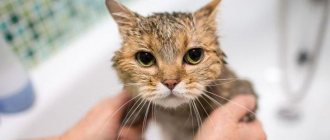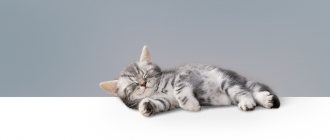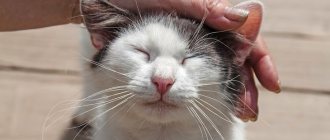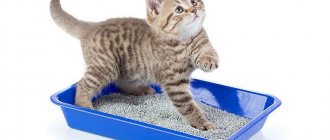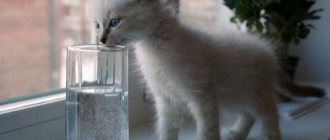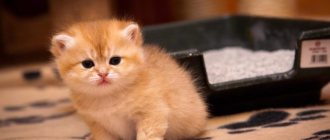The peculiarity of the life of cats suggests that they avoid water procedures because they are afraid of water. In part, this statement is not groundless, but can cats swim? Contrary to the established belief that cats cannot do this, it is worth noting: they swim excellently, and if in case of danger they need to overcome a water barrier, they will do it without difficulty. Moreover, there is a breed of fishing cats, whose life in the wild is unthinkable without hunting in water bodies.
Bathing is stressful
In cats, like most species of mammals, the ability to swim was developed during evolution, even before the process of domestication. In nature, it is survival of the fittest, so from the age of a kitten, animals can float on the water without any problems. In the event of an attack by predators or disasters (floods, fires), saving their own lives, they rush into the water and are able to stay there for a long time. Some individuals are driven into the water by hunger. This happens when there is not enough food on land.
If necessary, the cat can easily overcome water obstacles
Cats swim “like a dog”: scooping up water under themselves with their front paws. It turns out that this is simply wonderful for the cat family, but if you throw your pet into the water to test swimming skills, you can instill in the animal a fear of water procedures for a long time. It is necessary to accustom it gradually and better from an early age, then when bathing the pet will not violently resist.
Much depends on the breed and character of the cat. While some representatives are afraid of even the sounds of flowing water, others bathe with pleasure. Unfortunately they are a minority.
Note! It is more difficult to train an adult cat to bathe than a kitten.
Why cats can't stand water procedures
How to wash a rat at home, accustom it to water
It would seem that for pets, taking water procedures is a common occurrence; for most cats, bathing is still stressful. This is due to genetics, self-defense, again rooted in the distant past.
Maine Coon loves to swim
The instinct of self-preservation forces the cat not to put its own life in danger and not to go into the water unnecessarily, protecting it from a number of dangers:
- Hypothermia. Getting the fur wet can lead to hypothermia. The fact is that in cats there is an air gap between the skin and the pile. It plays the role of a thermostat and prevents the body from becoming overcooled. When the fur gets wet, the layer does not cope with the task, and the animal may simply freeze.
- Overheating. In hot conditions, this same layer saves you from overheating and maintains normal body temperature.
- Smell. Wet wool has a strong odor that attracts predators and repels prey. Cats go hunting, silently sneaking up on prey and attacking from ambush, and the smell of wet fur gives away its location. The opposite situation, when the cat becomes a victim of predators, forces it to avoid getting wet even in the rain.
- Infections. More dirt and microbes that cause various diseases stick to wet wool. When licked, they inevitably enter the body and lead to weakened immunity.
Why wash?
Cat breeders with extensive experience clearly believe that pets need to be bathed in the following cases:
- in the presence of parasites, fleas, ticks in the coat;
- if serious contamination appears;
- as a means of prevention;
- during molting.
During coat changes, water treatments are required.
Cats shed periodically. When an animal licks its own fur, dirt and germs enter the body with saliva. During the molting period, the amount of fur increases and it is difficult for the pet to cope with its natural shedding. Thus, the digestive system of the pet is the first to suffer. To avoid this problem, it is recommended to combine the molting period with bathing the cat.
What kind of cats love water?
Can dogs and cats laugh?
There are cat breeds that do not have such a negative attitude towards water.
Maine Coon
Cats of this breed, although large, are not at all aggressive, as it seems at first glance. On the contrary, immigrants from the USA have a rather peaceful character and friendliness, and quickly become attached to their owners.
It is worth noting their laziness: animals love to sleep and soak up the sun. However, when it comes to swimming, then a real little devil wakes up in them: they frolic, play, showing the character of a real hunter. The owner runs the risk of getting wet from head to toe, as their activity increases during water procedures.
Bengal cats
But Bengal cats are distinguished by their waywardness. Although they adore affection, they do not tolerate it if it is imposed.
Bengal cats decide when to bathe.
The beauties, with soft fur and a peculiar leopard pattern, are very smart and curious, but if you force them into water, they will certainly show their temper. Despite the fact that they can swim perfectly, cats decide for themselves when to do it.
American Bobtail
Another cat breed from the USA, the American Bobtail, which has more features in common with a dog than with individuals of its own kind, is also not afraid of water. To say that these cats can swim is an understatement. They are not only wonderful swimmers, but they are easy to train and require walking, so why not dogs?
Soukok
Purebred representatives of the African shorthair breed - Soukok - resemble a wild animal in their appearance. They have elongated hind limbs and original coloring. Cats are very energetic and love affection and actively show it themselves, rubbing against their owners’ legs. They are playful and love to frolic on land. If there is a pool at the cottage, they swim with pleasure. In a city apartment, while bathing, they flirt with the stream of water flowing from the tap.
Manx
There are legends about the tailless English Manx that he lost his tail when he jumped on Noah's Ark during the Great Flood. The door slammed at the last moment and cut off his luxurious decoration. This did not deprive them of their natural skills; cats swim perfectly.
Manx are very curious
The water seems to hypnotize them. They can spend hours watching the murmuring of the toilet flush, even flirting with it. They are trying to use it as a source of drinking water, but they do not like to swim forcibly. They do this only if they wish.
How to accustom a cat to water
How to accustom a cat to a new home - arrangement and adaptation options for your pet
No matter how negatively cats feel about water, they still need to wash themselves. This is a hygienic procedure that allows you to cleanse the animal of parasites after treatment. Here it is important not to make mistakes and remember a few important rules.
If this is already an adult pet, but is experiencing the need for bathing for the first time, it is better to give it a sedative intended specifically for cats before the process. The dosage must be determined by a veterinarian, since, as already mentioned, adult animals have difficulty getting used to this kind of activity.
Water procedures are necessary for pets
While bathing, do not shout at the animal, do not scold it, and be extremely calm yourself. It is better to wash your pet with an assistant whom he knows and trusts. Do not delay the washing process. The water temperature should be comfortable.
Frequent forced bathing is not healthy for cats. Wash them if necessary, if they are very dirty or have fleas. The standard regime is no more than once a year. They are already manic about their own appearance: they constantly lick their fur after every meal and visit to the toilet. Teaching an adult cat to love a bath is difficult.
Note! It is better to teach cats to bathe from childhood.
Dry shampoo is the way out
So, the owner decided that bathing the cat is an objective necessity, but the animal does not let itself be handled, bites, scratches and protests against water procedures in every possible way. What to do?
The way out is to use dry shampoo. Even though the effect of such a procedure is not comparable to the cleanliness after washing, treating the fur with this product gives cats less discomfort than bathing.
The powder from the bottle is applied to the animal’s fur coat directly with your hands, making massaging movements with your fingers. After this, so that the product is distributed evenly, the pet is combed. There is no need to wash off the powder with water.
It is important to take precautions when working with dry shampoo. Firstly, the procedure should be carried out in a room where the floors can be washed (it is almost impossible to remove spilled cleaning powder from the carpet without damaging the latter). Secondly, use the product no more than once every six months
Otherwise, the animal will develop an allergic reaction to the shampoo. This leads to a logical disappointing conclusion: dry cleaning products are not a panacea, and sooner or later the cat will have to be washed in the traditional way
Secondly, use the product no more than once every six months. Otherwise, the animal will develop an allergic reaction to the shampoo. This leads to a logical disappointing conclusion: dry cleaning products are not a panacea, and sooner or later the cat will have to be washed in the traditional way.
How to make addiction easier
You need to wash in a shallow basin standing on the floor. Little kittens experience an instinctive innate horror at the sight of high sides of the bathtub and pouring water. They associate them on a subconscious level with flooding, which means they are a command to escape. It’s good if the cat managed to get acquainted with the basin, sniff it, and play in it before bathing.
Bath a kitten from the age of 4 months
Before the process itself, put the kitten in a basin, let it get used to it and run around side by side. Pour non-chlorinated water into it, no more than 5-7 cm. The most comfortable temperature is 38-40 degrees. Place the kitten in the basin. Quickly wet his head, being careful not to get water into his ears and nose.
You need to be patient, do not scold or shout at the baby while bathing; it is better to calm him down with kind words if he meows loudly, showing fear. Do not delay the procedure.
After bathing, the baby should be wrapped in a warm towel, thoroughly blotted, and encouraged: milk, a favorite treat, a toy. If you are shaking, it means you are freezing, you need to change the towel to a dry and warm one, hold it in your arms, and calm it down. Use only special, hypoallergenic shampoos.
Note! Kittens aged 1-3 months should not be bathed unless absolutely necessary. The optimal age for the first wash is 4 months.
If the baby gets dirty in the cat litter box, it is better to wipe it with wet wipes or wash only the paws, but do not bathe the baby completely.
Preparation rules
The bathing process can be divided into 3 stages:
- preparation;
- bathing;
- drying
Before the washing procedure, it is necessary to prepare the bathroom and the animal itself. When caring for your cat, you will definitely need a furminator.
Baths
You should remove all hanging towels in the bathroom, because if the cat breaks out, he will cling to them, tear them, pull out the ties, and throw them to the floor.
You also need to put away soap dishes, shampoos, washcloths - everything that can get under the pussy's paw. It is better to bathe the animal in a bathtub with a terry towel or rubber mat placed at the bottom so that its paws do not slip along the bottom.
For a small kitten, the size of the bath will be large and will cause fear, so it must be placed in a bowl or in a sink. Since a cat’s body temperature is 38–39 °C, a comfortable water temperature for her will be 38–40 °C. The air temperature in the bathroom should not be lower than 15 °C.
Water must be collected in advance so that its noise does not frighten the mustachioed one. Its volume should be so large that it reaches the animal’s abdomen—approximately 15–20 cm.
Important! Shampoo for bathing a cat must be purchased specially, taking into account the characteristics of its fur. You should not wash it with soap, as it dries out the skin.
You should also prepare in advance all the necessary bathing accessories: shampoo, brush, washcloth, towels, laying them out in a row. The shampoo should be in the open state, because then you simply won’t be able to open it - your hands will be busy holding the shampoo. All accessories should be nearby so that you don’t have to reach far for them.
For washing, you should invite an assistant, since this procedure is best done with 4 hands.
Kota
Before you wash your cat in the bathroom, his claws need to be trimmed.
Find out how to make your own cat scratching post.
If there are hairballs on his fur, they must be carefully removed by hand. Before bathing, it is advisable to play with the kitty so that it relaxes
It is also important to prepare kind words for her and be patient.
The animal should be bathed after visiting the tray.
After all the preparatory procedures, you can already start swimming.
Interesting facts about waterfowl cats
The Turkish Van is considered a special waterfowl breed. Their front paws are equipped with special membranes that allow them to quickly row in the water, and their fur repels dirt and moisture well and practically does not get wet.
The Turkish Van is an excellent swimmer
The Turkish Van is an unsurpassed hunter; he chases not only rodents, his attention is attracted by various insects: beetles, butterflies, grasshoppers. If you need a fishing companion, he will be only too happy. He will happily spend time in nature, chasing a school of small fish in the shallows.
However, the fishing cat is rightfully considered the record holder for fishing. The wild swimming cat lives in southeast Asia (Indochina, Ceylon). Another name is speckled. Its weight can reach 15 kg. The cat has powerful jaws. It is unlikely that it would occur to anyone to tame an aggressive animal.
The front paws of the fishing cat, like those of the Turkish Van, are equipped with membranes. They prevent the claw plates from retracting and help in diving and fishing. With such equipment, it is not scary to swim long distances in search of prey. Swimming is his strong point, so the hunter lives near swamps, small lakes, and slow rivers flowing through tropical forests.
Cat fisherman with prey
Vivverina
Particularly interesting is the viverrina (felis viverrina), or, as it is also called, the Asian fish cat.
Her territory of residence is Hindustan, Sri Lanka, Indochina, Java, Bali, Sumatra. Vivverrina is a large animal, the average weight of males is 10-15 kg, females 6-7 kg. Surprisingly, this cat breed has webbed front paws. They prevent the cat from retracting its claws and help it catch fish. Representatives of this breed are not as graceful as other pussies, they do not like to climb trees, but they quite willingly wander through shallow water and, what is most interesting, choose deeper places! They are said to even dive 2 meters. So cats hunt underwater too. The vivverina's main diet consists of fish and crustaceans. It is worth saying that these creatures are not timid and are clearly not those who can answer the question “Why don’t cats like water?” There are known cases when a fishing cat scared a pack of dogs.
Many cats, especially kittens, are not averse to playing with water, and sometimes even ask to bathe them. It is worth noting that among the representatives of the cat family there are excellent swimmers. For example, jaguars, which not only swim, but also hunt fish and even turtles. And probably every person has seen a photo of a bathing tiger at least once in his life. They do this with great pleasure, but only in warm water.
Experts' opinion
Zoologists agree that most domestic cats are susceptible to a “genetic fear of water.” They also have a very sensitive olfactory system, and their owners, without thinking about these subtleties, use shampoos whose smell irritates them. All this makes cats shy away from water procedures, but they know how to swim.
Water treatments are a necessity for pets. But you should take into account their fear of water and act carefully. If the animal belongs to a breed that loves to swim and splash, it is worth providing it with this opportunity.
